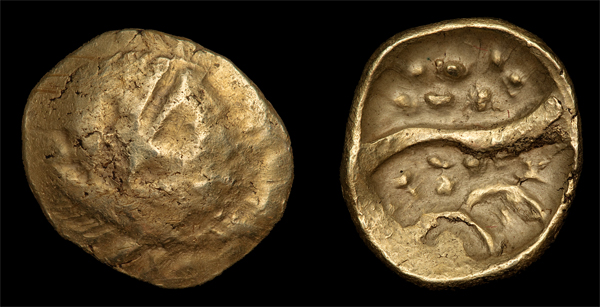
Unique ID: 85
This is an early Lyndsey Scyphate quarter stater which appears to follow on from the Lincolnshire Boat Tree quarters (see 25 and 33). The design on the obverse is normally described as a stylised boar, but I have a great deal of trouble accepting that for several reasons:
- The boar was revered as a creature of the night and only appears as the main motif on silver coins. It rarely appears on gold, and when it does, it is always a small auxiliary design
- The Celts knew how to draw boars that looked like boars. It was the little things, like having the correct number of legs and putting them in the correct places. This doesn’t really look like a boar.
- The coin is derived (one step removed) from Gallo-Belgic Ca2 Class 4 which was minted by the Morini and featured the standard “two men in a boat” motif. There are good arguments why a seafaring tribe (who are likely to have considered boats to be important) might have used a boat on their coins, but I’ve yet to hear any arguments put forth why they would have been the only tribe to use a badly drawn boar as the main image on gold
The design does become more boar like on later Lyndsey Scyphates, but I’m yet to be convinced it’s anything more than a boat with a figurehead. The Corieltavi used the boar extensively on their silver coins, and none of them look like this. They are all obviously boars even though they are highly abstract.
